Abstract
Immobilization of oligonucleotides containing 5'-terminal thiol groups on thiol-terminated paramagnetic Biomag beads via disulphide bond formation was investigated. Oligonucleotides are demonstrated to couple at high yields, the linkage is stable at 90 degrees C and is reversible, and the immobilized oligonucleotide is available for complementary, but not non-complementary, hybridization. Specific hybridization capacity per micrograms of immobilized oligonucleotide exceeds that achieved with other forms of immobilization chemistries employing random attachment and/or specific end attachment of the oligonucleotide to the solid support. Adsorption of DNA on the surface of the beads was decreased by incubation in 0.2% SDS; other non-specific blocking agents had no effect. Brief heating of the beads possessing immobilized oligonucleotides at 90 degrees C before hybridization increased the amount of specific hybridization dependent upon the inclusion of poly(dT) spacer sequences 5' to the immobilized oligonucleotide and 3' to the thiol group. Increasing lengths of spacers [up to a poly(dT16) spacer] linearly increased hybridization of complementary sequences.
Full text
PDF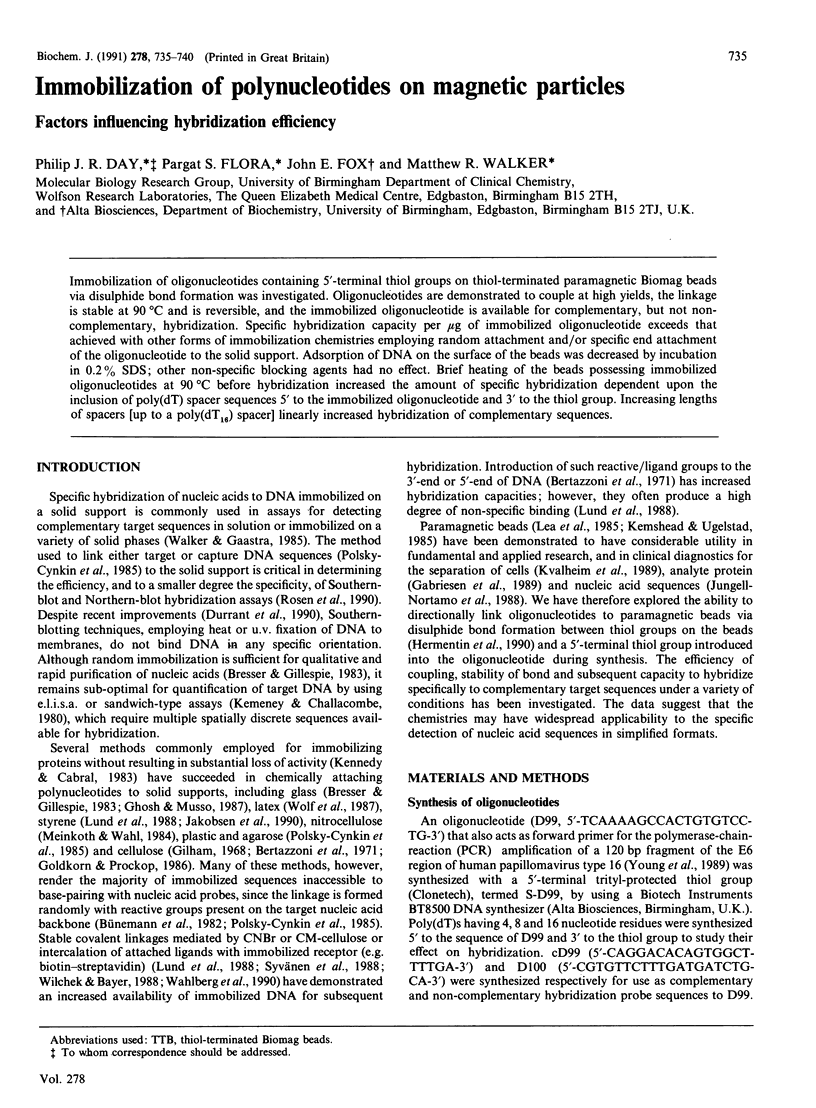
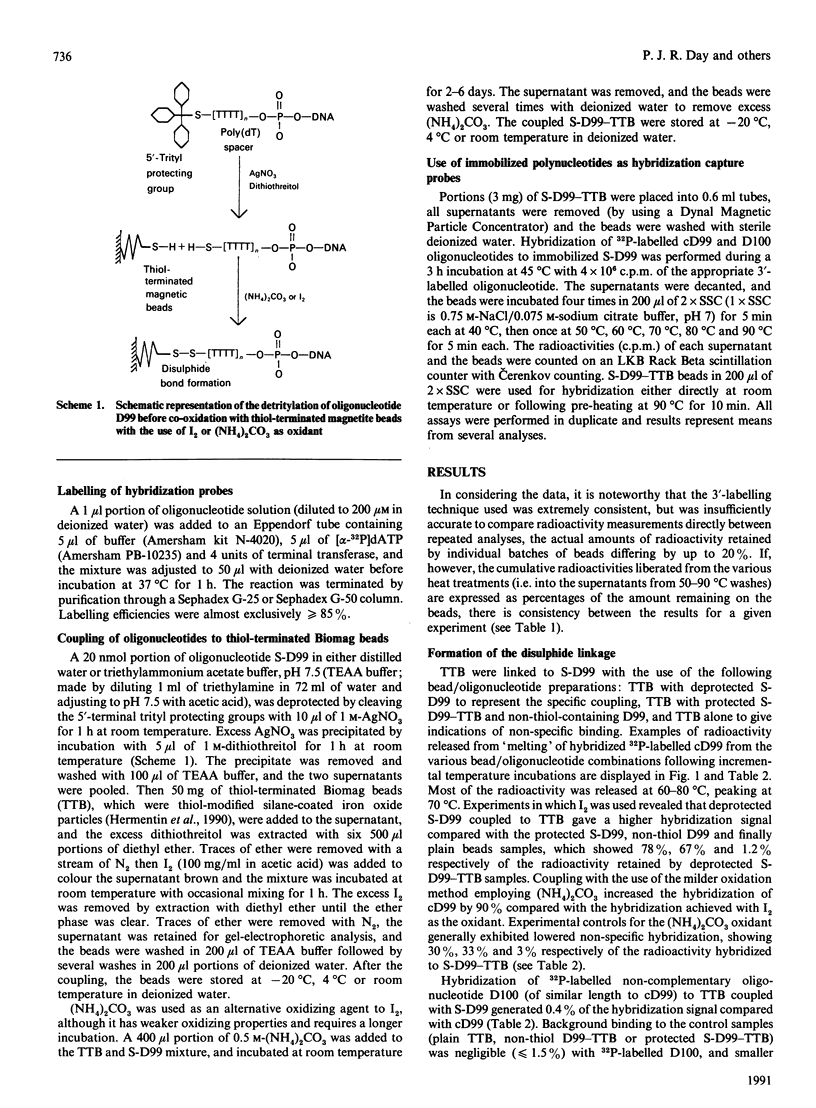

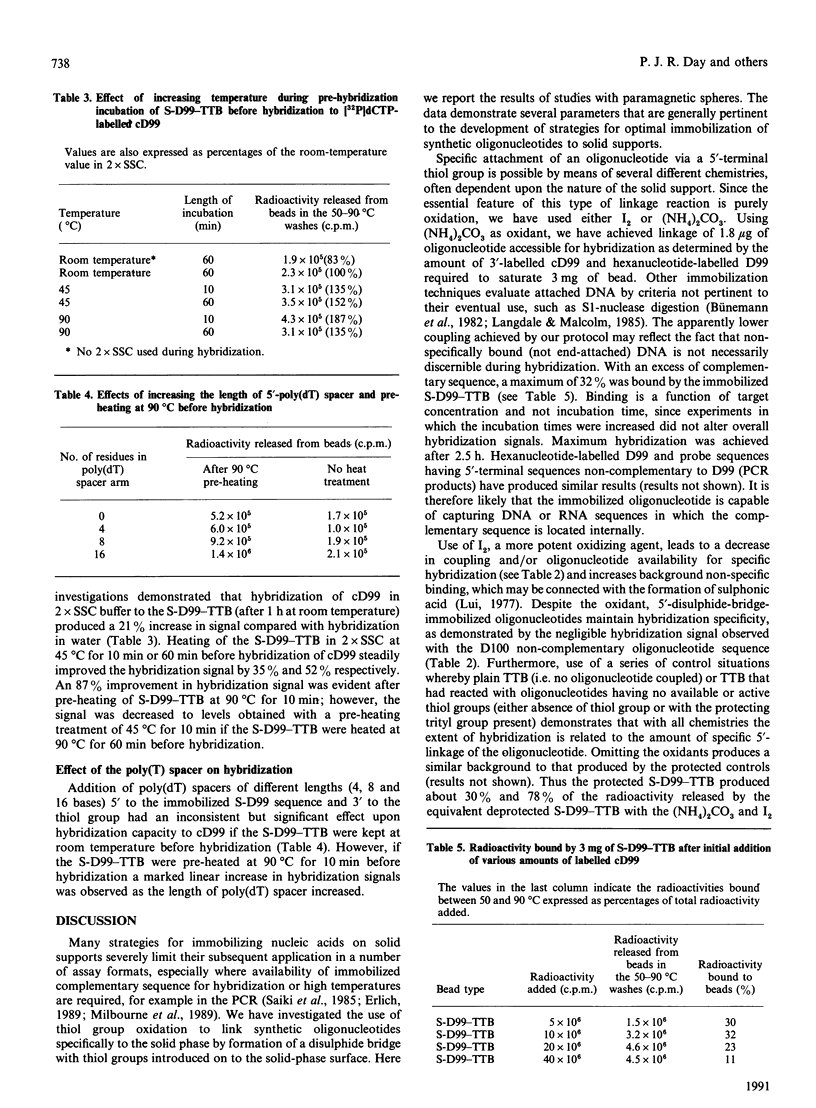
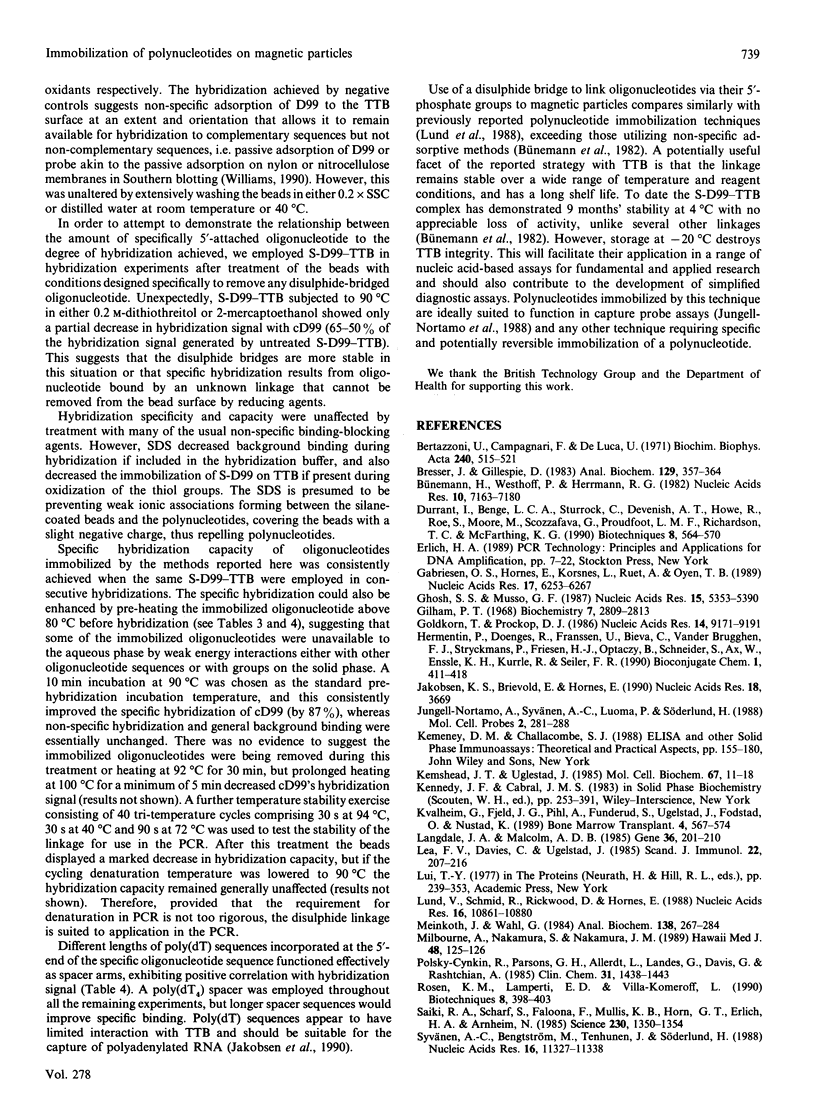
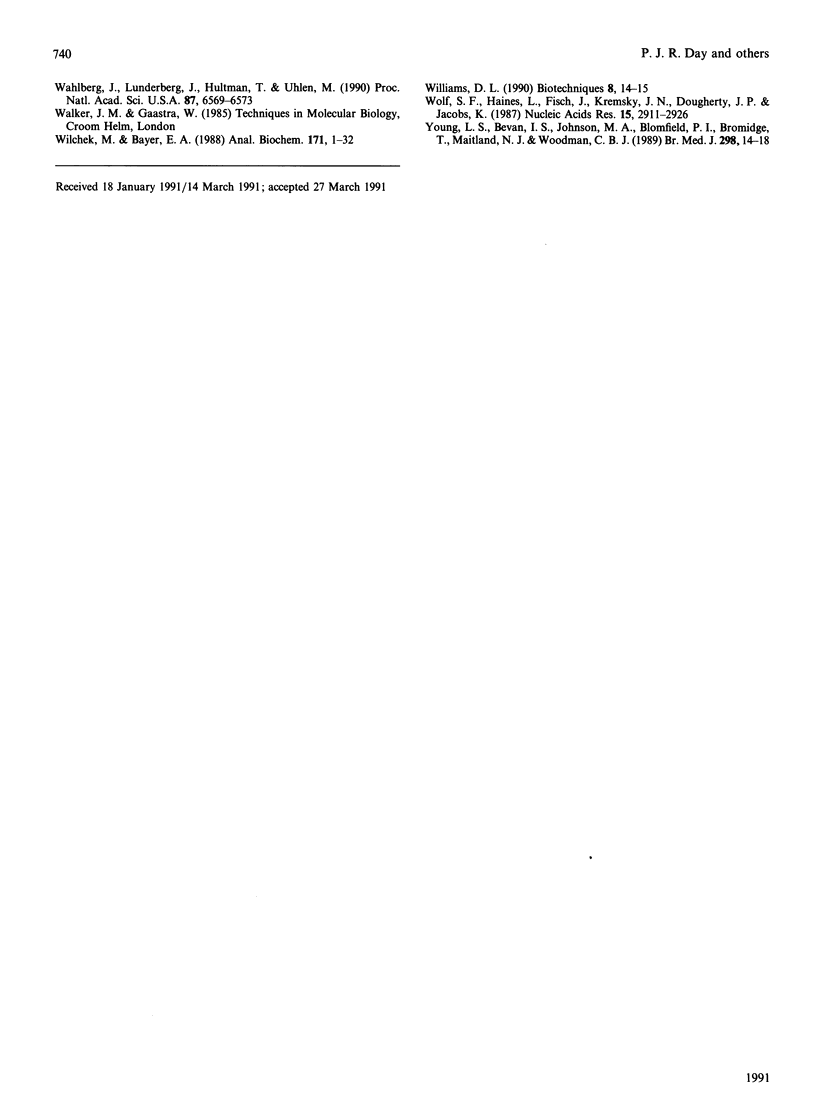
Selected References
These references are in PubMed. This may not be the complete list of references from this article.
- Bertazzoni U., Campagnari F., De Luca U. A convenient solid-state substrate for assays of polynucleotide ligase: the poly(dA)-(poly(( 3 H)dT)-poly(dT))-cellulose. Biochim Biophys Acta. 1971 Jul 29;240(4):515–521. doi: 10.1016/0005-2787(71)90708-8. [DOI] [PubMed] [Google Scholar]
- Bresser J., Gillespie D. Quantitative binding of covalently closed circular DNA to nitrocellulose in NaI. Anal Biochem. 1983 Mar;129(2):357–364. doi: 10.1016/0003-2697(83)90562-6. [DOI] [PubMed] [Google Scholar]
- Bünemann H., Westhoff P., Herrmann R. G. Immobilization of denatured DNA to macroporous supports: I. Efficiency of different coupling procedures. Nucleic Acids Res. 1982 Nov 25;10(22):7163–7180. doi: 10.1093/nar/10.22.7163. [DOI] [PMC free article] [PubMed] [Google Scholar]
- Durrant I., Benge L. C., Sturrock C., Devenish A. T., Howe R., Roe S., Moore M., Scozzafava G., Proudfoot L. M., Richardson T. C. The application of enhanced chemiluminescence to membrane-based nucleic acid detection. Biotechniques. 1990 May;8(5):564–570. [PubMed] [Google Scholar]
- Gabrielsen O. S., Hornes E., Korsnes L., Ruet A., Oyen T. B. Magnetic DNA affinity purification of yeast transcription factor tau--a new purification principle for the ultrarapid isolation of near homogeneous factor. Nucleic Acids Res. 1989 Aug 11;17(15):6253–6267. doi: 10.1093/nar/17.15.6253. [DOI] [PMC free article] [PubMed] [Google Scholar]
- Ghosh S. S., Musso G. F. Covalent attachment of oligonucleotides to solid supports. Nucleic Acids Res. 1987 Jul 10;15(13):5353–5372. doi: 10.1093/nar/15.13.5353. [DOI] [PMC free article] [PubMed] [Google Scholar]
- Gilham P. T. The synthesis of celluloses containing covalently bound nucleotides, polynucleotides, and nucleic acids. Biochemistry. 1968 Aug;7(8):2809–2813. doi: 10.1021/bi00848a016. [DOI] [PubMed] [Google Scholar]
- Goldkorn T., Prockop D. J. A simple and efficient enzymatic method for covalent attachment of DNA to cellulose. Application for hybridization-restriction analysis and for in vitro synthesis of DNA probes. Nucleic Acids Res. 1986 Nov 25;14(22):9171–9191. doi: 10.1093/nar/14.22.9171. [DOI] [PMC free article] [PubMed] [Google Scholar]
- Jakobsen K. S., Breivold E., Hornes E. Purification of mRNA directly from crude plant tissues in 15 minutes using magnetic oligo dT microspheres. Nucleic Acids Res. 1990 Jun 25;18(12):3669–3669. doi: 10.1093/nar/18.12.3669. [DOI] [PMC free article] [PubMed] [Google Scholar]
- Jungell-Nortamo A., Syvänen A. C., Luoma P., Söderlund H. Nucleic acid sandwich hybridization: enhanced reaction rate with magnetic microparticles as carriers. Mol Cell Probes. 1988 Dec;2(4):281–288. doi: 10.1016/0890-8508(88)90012-6. [DOI] [PubMed] [Google Scholar]
- Kemshead J. T., Ugelstad J. Magnetic separation techniques: their application to medicine. Mol Cell Biochem. 1985 May;67(1):11–18. doi: 10.1007/BF00220980. [DOI] [PubMed] [Google Scholar]
- Kvalheim G., Fjeld J. G., Pihl A., Funderud S., Ugelstad J., Fodstad O., Nustad K. Immunomagnetic removal of B-lymphoma cells using a novel mono-sized magnetizable polymer bead, M-280, in conjunction with primary IgM and IgG antibodies. Bone Marrow Transplant. 1989 Sep;4(5):567–574. [PubMed] [Google Scholar]
- Langdale J. A., Malcolm A. D. A rapid method of gene detection using DNA bound to Sephacryl. Gene. 1985;36(3):201–210. doi: 10.1016/0378-1119(85)90175-1. [DOI] [PubMed] [Google Scholar]
- Lea T., Vartdal F., Davies C., Ugelstad J. Magnetic monosized polymer particles for fast and specific fractionation of human mononuclear cells. Scand J Immunol. 1985 Aug;22(2):207–216. doi: 10.1111/j.1365-3083.1985.tb01873.x. [DOI] [PubMed] [Google Scholar]
- Lund V., Schmid R., Rickwood D., Hornes E. Assessment of methods for covalent binding of nucleic acids to magnetic beads, Dynabeads, and the characteristics of the bound nucleic acids in hybridization reactions. Nucleic Acids Res. 1988 Nov 25;16(22):10861–10880. doi: 10.1093/nar/16.22.10861. [DOI] [PMC free article] [PubMed] [Google Scholar]
- Meinkoth J., Wahl G. Hybridization of nucleic acids immobilized on solid supports. Anal Biochem. 1984 May 1;138(2):267–284. doi: 10.1016/0003-2697(84)90808-x. [DOI] [PubMed] [Google Scholar]
- Milbourne A., Nakamura S., Nakamura J. M. The polymerase chain reaction and its applications. Hawaii Med J. 1989 Apr;48(4):125–126. [PubMed] [Google Scholar]
- Polsky-Cynkin R., Parsons G. H., Allerdt L., Landes G., Davis G., Rashtchian A. Use of DNA immobilized on plastic and agarose supports to detect DNA by sandwich hybridization. Clin Chem. 1985 Sep;31(9):1438–1443. [PubMed] [Google Scholar]
- Rosen K. M., Lamperti E. D., Villa-Komaroff L. Optimizing the northern blot procedure. Biotechniques. 1990 Apr;8(4):398–403. [PubMed] [Google Scholar]
- Saiki R. K., Scharf S., Faloona F., Mullis K. B., Horn G. T., Erlich H. A., Arnheim N. Enzymatic amplification of beta-globin genomic sequences and restriction site analysis for diagnosis of sickle cell anemia. Science. 1985 Dec 20;230(4732):1350–1354. doi: 10.1126/science.2999980. [DOI] [PubMed] [Google Scholar]
- Syvänen A. C., Bengtström M., Tenhunen J., Söderlund H. Quantification of polymerase chain reaction products by affinity-based hybrid collection. Nucleic Acids Res. 1988 Dec 9;16(23):11327–11338. doi: 10.1093/nar/16.23.11327. [DOI] [PMC free article] [PubMed] [Google Scholar]
- Wahlberg J., Lundeberg J., Hultman T., Uhlén M. General colorimetric method for DNA diagnostics allowing direct solid-phase genomic sequencing of the positive samples. Proc Natl Acad Sci U S A. 1990 Sep;87(17):6569–6573. doi: 10.1073/pnas.87.17.6569. [DOI] [PMC free article] [PubMed] [Google Scholar]
- Wilchek M., Bayer E. A. The avidin-biotin complex in bioanalytical applications. Anal Biochem. 1988 May 15;171(1):1–32. doi: 10.1016/0003-2697(88)90120-0. [DOI] [PubMed] [Google Scholar]
- Williams D. L. The use of a PVDF membrane in the rapid immobilization of genomic DNA for dot-blot hybridization analysis. Biotechniques. 1990 Jan;8(1):14–15. [PubMed] [Google Scholar]
- Wolf S. F., Haines L., Fisch J., Kremsky J. N., Dougherty J. P., Jacobs K. Rapid hybridization kinetics of DNA attached to submicron latex particles. Nucleic Acids Res. 1987 Apr 10;15(7):2911–2926. doi: 10.1093/nar/15.7.2911. [DOI] [PMC free article] [PubMed] [Google Scholar]
- Young L. S., Bevan I. S., Johnson M. A., Blomfield P. I., Bromidge T., Maitland N. J., Woodman C. B. The polymerase chain reaction: a new epidemiological tool for investigating cervical human papillomavirus infection. BMJ. 1989 Jan 7;298(6665):14–18. doi: 10.1136/bmj.298.6665.14. [DOI] [PMC free article] [PubMed] [Google Scholar]


